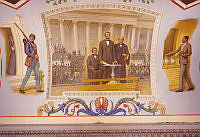The Working White House: A Mirror - The 20th Century
Copyright © White House Historical Association. All rights reserved under international copyright conventions. No part of this article may be reproduced or utilized in any form or by any means, electronic or mechanical, including photocopying, recording, or by any information storage and retrieval system, without permission in writing from the publisher. Requests for reprint permissions should be addressed to books@whha.org
Gallery
-

Elizabeth McDuffie (fourth from left) at first anniversary event of United Government Employees, 1937. McDuffie, a maid in the Roosevelt White House, served as a liaison between First Lady Eleanor Roosevelt and civil rights activists. McDuffie also energetically campaigned for Roosevelt in 1936 and 1940. With Mrs. Roosevelt’s apparent blessing, she was a leader in the United Government Employees, a union with a special following among lower-paid workers.
Robert W. Woodruff Library -

Notification of Personnel Action, 1948. Longtime chief butler and maître d’ Alonzo Fields received a raise of $330 (or 12.6 percent) in his annual salary. Fields helped ensure that White House employees received compensatory time off when they worked more than eight hours a day.
Mayland Fields -

Book cover, My Thirty Years Backstairs at the White House, 1961. Parks' memoir was adapted for an NBC television mini-series, Backstairs at the White House, in 1979. Parks began working as a maid and seamstress during the Hoover administration in 1929 and remained at the White House until 1960, nearly to the end of the Eisenhower administration. She and President Franklin D. Roosevelt shared a special bond because both had contracted polio.
Fleet Publishing -

Book cover, My 21 Years in the White House, 1961, by Alonzo Fields. When Fields first started working at the White House in 1931, he discovered there were “separate dining rooms—black and white. We all worked together, but we couldn’t eat together. . . . Here in the White House, I’m working for the President. This is the home of the democracy of the world and I’m good enough to handle the President’s food—to handle the President’s food and do everything—but I cannot eat with the [white] help.”
Coward-McCann -

First Lady Jacqueline Kennedy and White House staff, 1963. Taken at John F. Kennedy Jr.’s third birthday party, on December 6, 1963, this photograph reflects the racial diversity of the White House staff. (The boy’s actual birthday, November 25, 1963, was the date of his father’s funeral.)
John F. Kennedy Library and Museum/NARA -

Backstairs at the White House TV mini-series still, 1979. In the mini-series, Lillian Rogers Parks’ mother, Maggie Rogers, was played by Olivia Cole, with (left to right) Leslie Nielsen as Chief Usher Ike Hoover and Robert Vaughn as President Woodrow Wilson.
Ed Friendly Trust and National Broadcasting Company
Twentieth-century historical forces and social movements left their marks on the working White House. In 1900, nearly 87,000 inhabitants (almost a third of the population) of Washington, D.C., were black, forming the largest urban community of African Americans anywhere in the United States. However, racial segregation, as a formal policy, was endorsed and enforced in the Taft White House (1909-13), and remained an accepted household management practice for many decades.
World Wars I and II depleted the White House residence staff as workers were called up for military service. The Great Depression meant tight wages, and war rationing affected the types of meals prepared for the First Family. Although a moratorium on entertaining from 1941 to 1946 curtailed certain employee tasks, workers continued to play a vital role in the operations of the White House.
First Lady Eleanor Roosevelt, widely known for her interest in labor issues and human rights efforts, made it a point to seek the advice and counsel of White House workers during the Franklin Roosevelt administration. As a result, many White House workers encountered improved working conditions and more enlightened attitudes towards household staff in general, and African Americans in particular.











